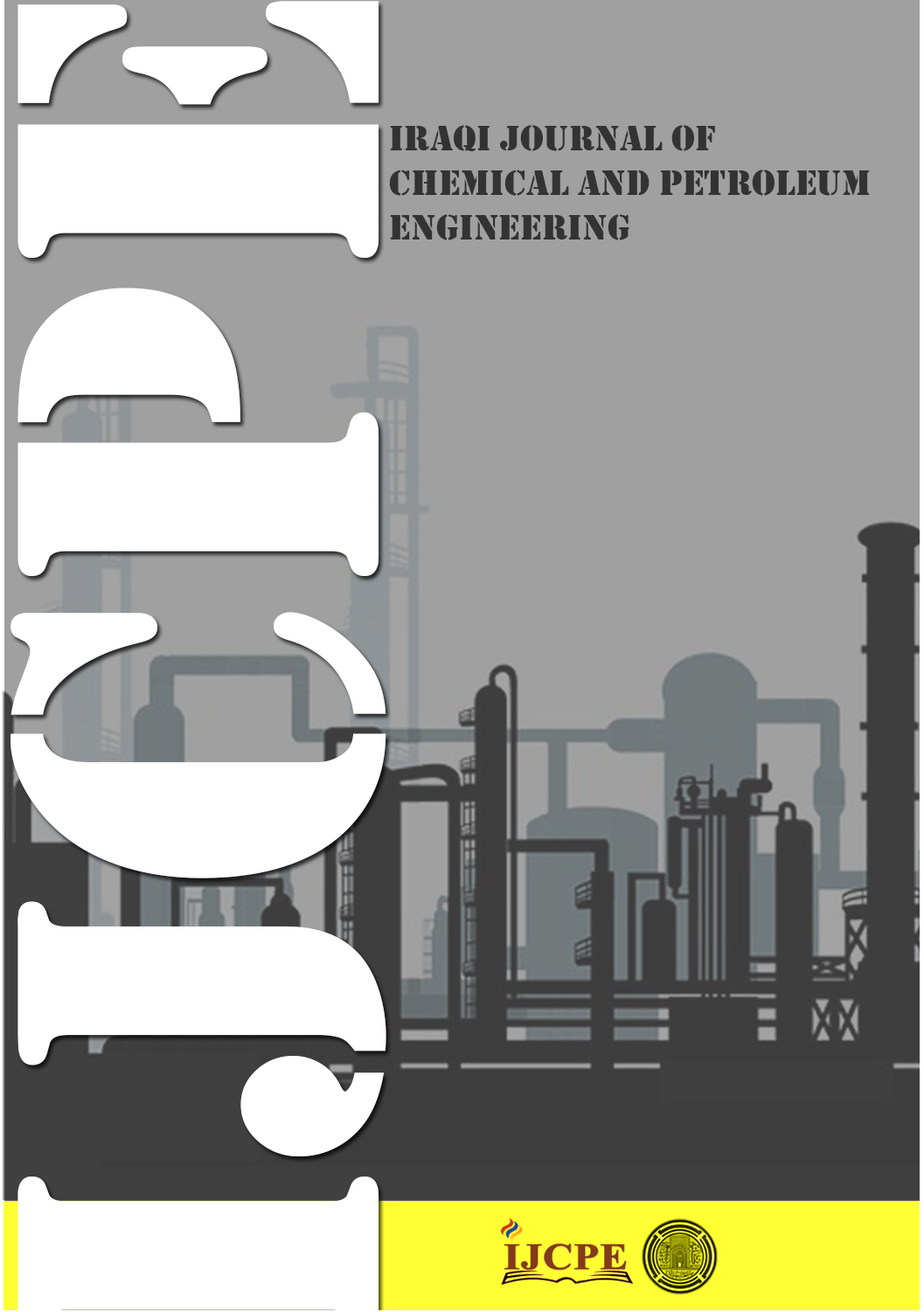Utilizing red Iraqi kaolin for methylene blue sorption from aqueous solutions
DOI:
https://doi.org/10.31699/IJCPE.2025.3.8Keywords:
Methylene blue; Iraqi kaolin; sorption; wastewater treatment; kinetic modeling; and sorption isothermsAbstract
This paper explores the sorption potential of red Iraqi kaolin (IRK) for methylene blue (MB) elimination by sorption process. Batch tests were examined the impact of agitation time, IRK dose, pH, shaking speed, and MB concentration. The results demonstrated that IRK effectively removes MB, achieving a maximum elimination efficiency of 91.976% within 0.05 g/100 mL, 120 min, 7, 200 rpm and 50 mg/L for IRK dosage, contact duration, pH, shaking speed, and concentration of MB, respectively. The kinetic analysis showed that the sorption mechanism was fitted a pseudo 2nd order, therefore chemisorption is the primary mechanism. Intra-particle diffusion investigation demonstrated that the sorption mechanism is influenced by many concurrent procedures, particularly surface complexation and ion exchange. In addition, the Freundlich isotherm model fits the experiment's measurement higher than the Langmuir model, showing the heterogeneous surface features of IRK and the maximum sorption capacity (qmax) equal to 587.08 mg/g. The current investigation demonstrates the possibility of IRK as an effective and inexpensive sorbent for wastewater treatment applications, opening up opportunities for further research into sorbent regeneration and real-world wastewater situations.
Received on 15/11/2024
Received in Revised Form on 11/01/2025
Accepted on 12/01/2025
Published on 30/09/2025
References
[1] D. A. Yaseen and M.Scholz, “Textile dye wastewater characteristics and constituents of synthetic effluents : a critical review,” International Journal of Environmental Science and Technology, vol. 16, no. 2, pp. 1193–1226, 2019, https://doi.org/10.1007/s13762-018-2130-z
[2] G. Crini, G. Torri, E. Lichtfouse, G. Z. Kyzas, L. D. Wilson, and N. Morin-crini, “Dye removal by biosorption using cross-linked chitosan-based hydrogels,” Environmental Chemistry Letters, vol. 17, no. 4, pp. 1645–1666, 2019, https://doi.org/10.1007/s10311-019-00903-y
[3] S. Liu, Q. Wang, H. Ma, P. Huang, J. Li, and T. Kikuchi, “Effect of micro-bubbles on coagulation flotation process of dyeing wastewater,” Separation and Purification Technology, vol. 71, no. 3, pp. 337–346, Mar. 2010, https://doi.org/10.1016/j.seppur.2009.12.021
[4] G. L. Dotto et al., “Development of chitosan/bentonite hybrid composite to remove hazardous anionic and cationic dyes from colored effluents,” Journal of Environmental Chemical Engineering, vol. 4, no. 3, pp. 3230–3239, Sep. 2016, https://doi.org/10.1016/j.jece.2016.07.004
[5] J. Georgin, G. L. Dotto, M. A. Mazutti, and E. L. Foletto, “Preparation of activated carbon from peanut shell by conventional pyrolysis and microwave irradiation-pyrolysis to remove organic dyes from aqueous solutions,” Journal of Environmental Chemical Engineering, vol. 4, no. 1, pp. 266–275, Mar. 2016, https://doi.org/10.1016/j.jece.2015.11.018
[6] R. Kant, “Textile dyeing industry an environmental hazard,” Natural Science, vol. 04, no. 01, pp. 22–26, 2012, https://doi.org/10.4236/ns.2012.41004
[7] E. da C. Severo, C. G. A. Anchieta, V. S. Foletto, and M. A. Kuhn, Raquel Cristine Collazzo, Gabriela Carvalho Mazutti, “Degradation of Amaranth azo dye in water by heterogeneous photo-Fenton process using FeWO 4 catalyst prepared by microwave irradiation,” Water Science and Technology, pp. 88–94, 2016, https://doi.org/10.2166/wst.2015.469
[8] C. G. Anchieta et al., “Rapid and facile preparation of zinc ferrite (ZnFe2O4) oxide by microwave-solvothermal technique and its catalytic activity in heterogeneous photo-Fenton reaction,” Materials Chemistry and Physics, pp. 1–7, 2015, https://doi.org/10.1016/j.matchemphys.2015.04.016
[9] A. A. Atia, A. M. Donia, and W. A. Al-amrani, “Adsorption/desorption behavior of acid orange 10 on magnetic silica modified with amine groups,” Chemical Engineering Journal, vol. 150, pp. 55–62, 2009, https://doi.org/10.1016/j.cej.2008.12.004
[10] Z. Salahshoor and A. Shahbazi, “Review of the use of mesoporous silicas for removing dye from textile wastewater,” European Journal of Environmental Sciences, vol. 4, no. 2, pp. 116–130, Dec. 2014, https://doi.org/10.14712/23361964.2014.7
[11] M. Ghaedi, A. G. Nasab, S. Khodadoust, M. Rajabi, and S. Azizian, “Application of activated carbon as adsorbents for efficient removal of methylene blue: Kinetics and equilibrium study,” Journal of Industrial and Engineering Chemistry, vol. 20, no. 4, pp. 2317–2324, Jul. 2014, https://doi.org/10.1016/j.jiec.2013.10.007
[12] K. Khalid, M. A. K. M. Hanafiah, and W. K. A. W. M. Khalir, “Effect of Physicochemical Parameters on Methylene Blue Adsorption by Sulfuric Acid Treated Spent Grated Coconut,” Applied Mechanics and Materials, pp. 71–76, 2015, https://doi.org/10.4028/www.scientific.net/AMM.752-753.71
[13] S. I. Siddiqui, G. Rathi, and S. A. Chaudhry, “Acid washed black cumin seed powder preparation for adsorption of methylene blue dye from aqueous solution: Thermodynamic, kinetic and isotherm studies,” Journal of Molecular Liquids, vol. 264, pp. 275–284, Aug. 2018, https://doi.org/10.1016/j.molliq.2018.05.065
[14] N. Yuan, H. Cai, T. Liu, Q. Huang, and X. Zhang, “Adsorptive removal of methylene blue from aqueous solution using coal fly ash-derived mesoporous silica material,” Adsorption Science and Technology, vol. 37, no. 3–4, pp. 333–348, May 2019, https://doi.org/10.1177/0263617419827438
[15] T.-C. Lee et al., “Tea stem as a sorbent for removal of methylene blue from aqueous phase,” Advances in Materials Science and Engineering, vol. 2019, 2019, https://doi.org/10.1155/2019/9723763
[16] D. Lin et al., “Adsorption of Dye by Waste Black Tea Powder: Parameters, Kinetic, Equilibrium, and Thermodynamic Studies,” Journal of Chemistry, vol. 2020, 2020, https://doi.org/10.1155/2020/5431046
[17] R. Singh, T. S. Singh, J. O. Odiyo, J. A. Smith, and J. N. Edokpayi, “Evaluation of Methylene Blue Sorption onto Low-Cost Biosorbents: Equilibrium, Kinetics, and Thermodynamics,” Journal of Chemistry, vol. 2020, 2020, https://doi.org/10.1155/2020/8318049
[18] M. Y.Tamar-Agha, M. A. A. Mahdi, and A. A. A. Ibrahim, “The Kaolin Clay Deposits in the Western Desert of Iraq: an Overeview,” Iraqi Bulletin of Geology and Mining, no. 8, pp. 147–173, 2019.
[19] S. Ethaib and S. L. Zubaidi, “Removal of Methylene Blue Dye from Aqueous Solution Using Kaolin,” in IOP Conference Series: Materials Science and Engineering, Iraq, 2020, p. 7. https://doi.org/10.1088/1757-899X/928/2/022030
[20] S. J. Olusegun, L. F. de Sousa Lima, and N. D. S. Mohallem, “Enhancement of adsorption capacity of clay through spray drying and surface modification process for wastewater treatment,” Chemical Engineering Journal, vol. 334, pp. 1719–1728, Feb. 2018, https://doi.org/10.1016/j.cej.2017.11.084
[21] F. P. Sejie and M. S. Nadiye-tabbiruka, “Removal of Methyl Orange ( MO ) from Water by adsorption onto Modified Local Clay ( Kaolinite ),” Physical Chemistry, vol. 6, no. 2, pp. 39–48, 2016.
[22] N. Caponi, G. C. Collazzo, S. L. Jahn, G. L. Dotto, M. A. Mazutti, and E. L. Foletto, “Use of Brazilian Kaolin as a Potential Low-cost Adsorbent for the Removal of Malachite Green from Colored Effluents,” in Materials Research, Universidade Federal de Sao Carlos, 2017, pp. 14–22. https://doi.org/10.1590/1980-5373-mr-2016-0673
[23] G. K. Sarma, S. S. Gupta, and K. G. Bhattacharyya, “Removal of hazardous basic dyes from aqueous solution by adsorption onto kaolinite and acid-treated kaolinite: kinetics, isotherm and mechanistic study,” SN Applied Sciences, vol. 1, no. 3, Mar. 2019, https://doi.org/10.1007/s42452-019-0216-y
[24] Momina, M. Shahadat, and S. Isamil, “Regeneration performance of clay-based adsorbents for the removal of industrial dyes: A review,” Royal Society of Chemistry, vol. 8, no. 43, pp. 24571-24587, 2018, https://doi.org/10.1039/c8ra04290j
[25] M. D. Mullassery, N. B. Fernandez, and T. S. Anirudhan, “Adsorptive removal of acid red from aqueous solutions by cationic surfactant-modified bentonite clay,” Desalination and Water Treatment, vol. 56, no. 7, pp. 1929–1939, 2015, https://doi.org/10.1080/19443994.2014.958110
[26] G. Limousin, J. P. Gaudet, L. Charlet, S. Szenknect, V. Barthès, and M. Krimissa, “Sorption isotherms: A review on physical bases, modeling and measurement,” Applied Geochemistry, vol. 22, pp. 249-275, 2007, https://doi.org/10.1016/j.apgeochem.2006.09.010
[27] A. A. H. Faisal, L. A. Naji, A. A. Chaudhary, and B. Saleh, “Removal of ammoniacal nitrogen from contaminated groundwater using waste foundry sand in the permeable reactive barrier,” Desalination and Water Treatment, vol. 230, pp. 227–239, 2021, https://doi.org/10.5004/dwt.2021.27436
[28] A. A. H. Faisal and L. A. Naji, “Simulation of Ammonia Nitrogen Removal from Simulated Wastewater by Sorption onto Waste Foundry Sand Using Artificial Neural Network,” Association of Arab Universities Journal of Engineering Sciences, vol. 26, pp. 28–34, 2019, https://doi.org/10.33261/jaaru.2019.26.1.004
[29] L. A. Naji, S. H. Jassam, M. J. Yaseen, A. A. H. Faisal, and N. Al-ansari, “Modification of Langmuir model for simulating initial pH and temperature effects on sorption process,” Separation Science and Technology, vol. 0, no. 00, pp. 1–8, 2020, https://doi.org/10.1080/01496395.2019.1655055
[30] N. Saad, Z. T. A. Ali, L. A. Naji, A. A. A. H. Faisal, and N. Al-Ansari, “Development of Bi-Langmuir model on the sorption of cadmium onto waste foundry sand: Effects of initial pH and temperature,” Environmental Engineering Research, vol. 25, no. 5, pp. 677–684, 2020, https://doi.org/10.4491/eer.2019.277
[31] M. T. Yagub, T. K. Sen, and H. M. Ang, “Equilibrium, kinetics, and thermodynamics of methylene blue adsorption by pine tree leaves,” Water, Air, and Soil Pollution, vol. 223, 2012, https://doi.org/10.1007/s11270-012-1277-3
[32] E. Bulut, M. Özacar, and I. A. Şengil, “Equilibrium and kinetic data and process design for adsorption of Congo Red onto bentonite,” Journal of Hazardous Materials, vol. 154, no. 1–3, pp. 613–622, 2008, https://doi.org/10.1016/j.jhazmat.2007.10.071
[33] Z. T. Abd Ali et al., “Predominant mechanisms for the removal of nickel metal ion from aqueous solution using cement kiln dust,” Journal of Water Process Engineering, vol. 33, no. September 2019, p. 101033, 2020, https://doi.org/10.1016/j.jwpe.2019.101033
[34] T. A. Aragaw and F. T. Angerasa, “Synthesis and characterization of Ethiopian kaolin for the removal of basic yellow (BY 28) dye from aqueous solution as a potential adsorbent,” Heliyon, vol. 6, no. June, p. e04975, 2020, https://doi.org/10.1016/j.heliyon.2020.e04975
[35] Z. Huang et al., “Modified bentonite adsorption of organic pollutants of dye wastewater,” Materials Chemistry and Physics, vol. 202, pp. 266–276, 2017, https://doi.org/10.1016/j.matchemphys.2017.09.028
[36] A. H. Jawad and A. S. Abdulhameed, “Mesoporous Iraqi red kaolin clay as an efficient adsorbent for methylene blue dye: Adsorption kinetic, isotherm and mechanism study,” Surfaces and Interfaces, p. 100422, 2020, https://doi.org/10.1016/j.surfin.2019.100422
[37] N. Hamri et al., “Enhanced Adsorption Capacity of Methylene Blue Dye onto Kaolin through Acid Treatment: Batch Adsorption and Machine Learning Studies,” Water (Switzerland), vol. 16, no. 2, pp. 1–23, 2024, https://doi.org/10.3390/w16020243
[38] H. N. Hamad et al., “Optimized Bentonite Clay Adsorbents for Methylene Blue Removal,” Processes, vol. 12, no. 4, 2024, https://doi.org/10.3390/pr12040738
[39] C. P. Sagita, L. Nulandaya, and Y. S. Kurniawan, “Efficient and Low-Cost Removal of Methylene Blue using Activated Natural Kaolinite Material,” Journal of Multidisciplinary Applied Natural Science, 2021, https://doi.org/10.47352/jmans.v1i2.80
[40] N. Kannan and M. M. Sundaram, “Kinetics and mechanism of removal of methylene blue by adsorption on various carbons - A comparative study,” Dyes and Pigments, vol. 51, no. 1, pp. 25–40, 2001, https://doi.org/10.1016/S0143-7208(01)00056-0
[41] T. S. Anirudhan and M. Ramachandran, “Adsorptive removal of basic dyes from aqueous solutions by surfactant modified bentonite clay (organoclay): Kinetic and competitive adsorption isotherm,” Process Safety and Environmental Protection, vol. 95, pp. 215–225, May 2015, https://doi.org/10.1016/j.psep.2015.03.003
[42] L. A. Naji, A. A. H. Faisal, H. M. Rashid, M. Naushad, and T. Ahamad, “Environmental remediation of synthetic leachate produced from sanitary landfills using low-cost composite sorbent,” Environmental Technology and Innovation, vol. 18, p. 100680, 2020, https://doi.org/10.1016/j.eti.2020.100680
[43] M. Alshammari et al., “Synthesis of a Novel Composite Sorbent Coated with Siderite Nanoparticles and its Application for Remediation of Water Contaminated with Congo Red Dye,” International Journal of Environmental Research, vol. 14, no. 2, pp. 177–191, 2020, https://doi.org/10.1007/s41742-020-00245-6
[44] V. K. Gupta and Suhas, “Application of low-cost adsorbents for dye removal - A review,” Journal of Environmental Management, vol. 90, no. 8, pp. 2313-2342, 2009, https://doi.org/10.1016/j.jenvman.2008.11.017
[45] Z. R. Komy, A. M. Shaker, S. E. M. Heggy, and M. E. A. El-Sayed, “Kinetic study for copper adsorption onto soil minerals in the absence and presence of humic acid,” Chemosphere, vol. 99, pp. 117–124, Mar. 2014, https://doi.org/10.1016/j.chemosphere.2013.10.048
[46] W. H. Cheung, Y. S. Szeto, and G. McKay, “Intraparticle diffusion processes during acid dye adsorption onto chitosan,” Bioresource Technology, vol. 98, no. 15, pp. 2897–2904, Nov. 2007, https://doi.org/10.1016/j.biortech.2006.09.045
Downloads
Published
Issue
Section
License
Copyright (c) 2025 The Author(s). Published by College of Engineering, University of Baghdad.

This work is licensed under a Creative Commons Attribution 4.0 International License.













